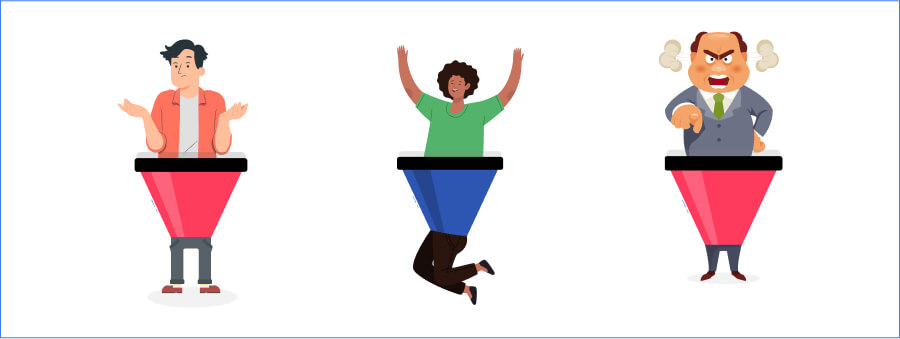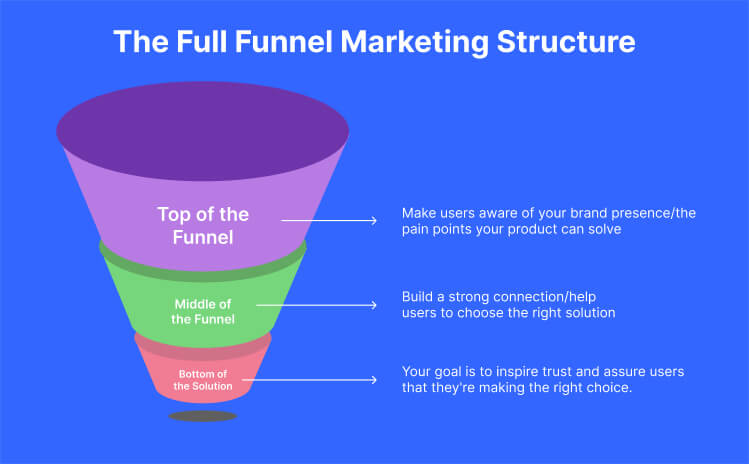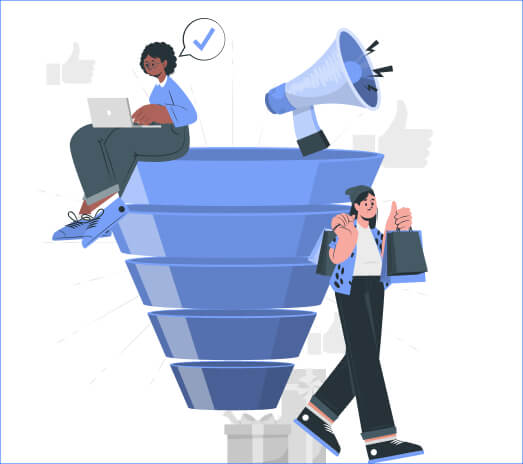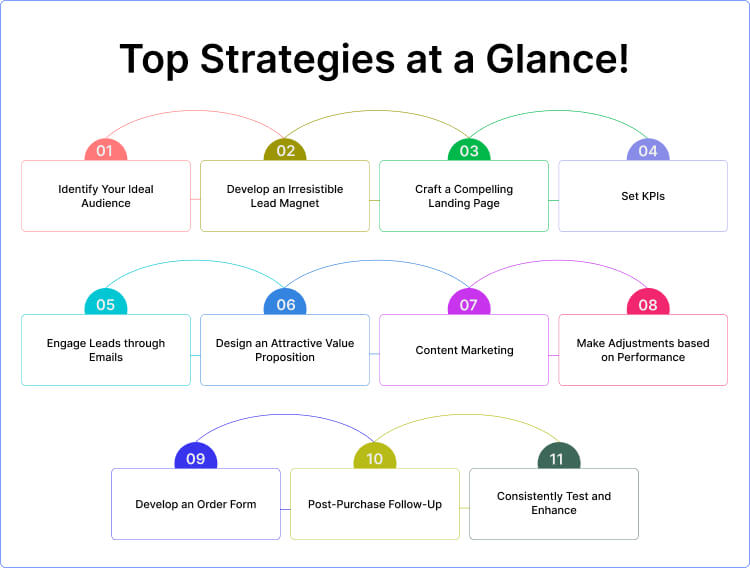Imagine your website as a bustling marketplace, with visitors flowing in like curious window shoppers. Surprisingly, many of these visitors are not ready to make a purchase right away. But don’t be disheartened! There’s a powerful strategy to turn these window shoppers into loyal customers, and it’s called full-funnel marketing.
Full-funnel marketing is like a guide through the customer journey. It’s a step-by-step process that begins with creating awareness about your brand among the right people. As these potential customers move along, you aim to capture their contact information and, eventually, convince them to make a purchase.
Successful marketing isn’t just about catching the low-hanging fruit; it’s about cultivating a relationship with customers at every stage. By implementing a full-funnel strategy, you’re not just selling a product; you’re crafting a journey that turns curious visitors into satisfied customers.
Curious about the ins and outs of a full-funnel marketing strategy? Keep reading this space for more!
What is Full Funnel Marketing?
Full-funnel marketing is a thoughtfully crafted system designed to capture, nurture, educate, and allure users, gradually turning them into customers.
Now, picture a funnel – not the kitchen tool, but a marketing funnel. It’s a simple map of how customers usually go from just knowing about a product to actually buying it. Full-funnel marketing kicks off at the top of this funnel and keeps in mind what customers need at every step.
The cool thing? It’s not all about pushing for sales. Full-funnel marketing is like making a good friend out of your brand. It’s about creating an awesome experience, not just selling stuff.
Implementing a comprehensive marketing approach can increase your return on investment (ROI) by 45% and enhance offline sales by 7%. So, instead of just aiming for a quick sale, it focuses on building a brand that people love and trust.
3 Important Stages of the Marketing Funnel
The marketing funnel covers the complete customer journey and is commonly described in three stages.
1. Top of the Funnel: Awareness
Imagine it as the starting point of a new friendship with your potential customers. This is where they first get to know your brand, like meeting someone for the first time. At this stage, they might not be familiar with all the cool things your product or service can do.
So, what do you do at the top of the funnel? Think of it as introducing yourself and showing off your brand’s personality. Use engaging content and marketing material to spread the word about what makes your brand awesome.
In this lead generation stage, the goal is to attract these curious prospects and give them a taste of what you have to offer. So, wave hello from the top of the funnel and let the adventure begin!
2. Middle of the Funnel: Consideration
At this stage, your audience has gone beyond just waving at your brand; they’re diving deeper. Maybe they’ve joined your email list, started following you on social media, or even signed up for a webinar you’re hosting. They’re not just passing by; they’re hanging out and getting to know you better.
So, what’s the plan for the middle of the funnel? It’s all about building a strong connection. Think of it as the phase where you’re not just acquaintances anymore; you’re becoming friends. Share valuable content, answer their questions, and show them the awesome side of your product or service.
3. Bottom of the Funnel: Conversion
Congratulations! You’ve put in the effort, and your potential customers are almost ready to take the plunge. Now, at the bottom of the funnel, it’s time to seal the deal and make them feel super confident about hitting that “buy” button.
Think of this stage as the moment before a big decision. Your goal is to inspire trust and assure them that they’re making the right choice. How? Well, real stories from happy customers work like magic. Testimonials, case studies, and customer reviews can work wonders here. They show that others have had a great experience, and it’s safe to trust your brand.
But wait, there’s more! You can sweeten the deal by offering extra perks. Imagine tossing in free trials, discounts, coupons, or even free shipping.
Importance of Full Funnel Marketing
Full funnel marketing isn’t just a cool idea; it’s a must-have strategy for your business. It works like a treasure map that shows exactly where your journey with customers might be springing a leak. Fixing these leaks becomes your number one priority, and here’s why it’s so important!
-
Know Your Customers In and Out
So, full-funnel marketing isn’t just about numbers and graphs; it’s about knowing your customers like friends. Well, when you know exactly where your customers are coming from and where they’re headed, you can create super personalized marketing strategies. It’s like tailoring your messages and offers to fit them perfectly, making your brand connect with them in a way that feels just right.
-
Increased Conversions
There are different stages on this journey, and by paying attention to each of these stages, your business can be like the ultimate tour guide, leading potential customers in the best way possible toward making a purchase.
-
Makes You More Efficient
Full-funnel marketing helps you see which strategies are your secret weapons for success at each step. Now, here’s the exciting part – once you know what works best, you can focus on your efforts and resources like a laser beam. It’s not about doing a little bit of everything; it’s about doing the right things at the right time.
-
Higher Customer Retention
Once someone buys from you, it’s not the end, it’s a new beginning. Full-funnel marketing helps you keep the conversation going. Post-purchase engagement keeps your brand on their mind, promotes loyalty (like having a friend they trust), and even encourages them to come back for more.
How to Develop a Full Funnel Marketing Strategy?
Imagine your marketing journey as a funnel – a big one with different stages. Each stage is like a step in a customer’s journey, from first hearing about your product to becoming a loyal customer. Now, a full-funnel marketing strategy is like the glue that holds these stages together smoothly.
The goal here is to make it easy for people to go from one stage to another, without any bumps or confusion. To make it work, you need to understand how each stage connects and shapes the path a person takes to become your customer.
So, let’s break down how to create a killer full-funnel marketing strategy:
-
Identify Your Ideal Audience
Before you start promoting your product or service to everyone, it’s important to figure out exactly who you want to reach. Imagine creating imaginary friends – let’s call them personas – who represent your ideal customers. Picture things like how old they are, whether they’re male or female, and what kind of job they have. This helps you build a picture of who these people are, what problems they might be dealing with, and what they like in a brand.
The best thing is, by understanding your imaginary friends (your personas), you can then decide where to share your messages. Different people hang out in different places, right? So, this step helps you choose the right places, like social media or specific websites, to talk to your ideal customers.
-
Develop an Irresistible Lead Magnet
Now that you know who you want to talk to, you need something interesting to catch their attention. This special thing is called a “lead magnet.” Think of it like a tasty treat that attracts people into your world of products or services. Whether someone is just getting to know your brand or is ready to make a purchase, having different lead magnets helps keep them interested and engaged.
Lead magnets come in different shapes and sizes. Here are some examples!
- Product samples or free trials
- White papers
- Free consultations
- E-books
- Newsletters
- Webinars
- Tutorial Videos
-
Craft a Compelling Landing Page
So, you’ve grabbed someone’s attention, and now it’s time to impress him when he visits your website. Imagine this moment like a first date – your chance to make a great first impression. The place where this date happens is called a “landing page.”
Whether someone found you through an ad or searched for your brand on Google, the landing page is where they land, like arriving at your front door. Now, the main job of this page is simple: to convince your visitors to do something. And that “something” could be different for everyone – it might be buying something, signing up for a webinar, booking a free consultation, or subscribing to your newsletter.
So, a clear and inviting “call to action” on the landing page is like asking someone on that second date – it’s the key to keeping the connection going.
-
Set KPIs
Now let’s talk about something called KPIs – Key Performance Indicators. These are like measuring tools for your marketing efforts. and work as scorecards that tell you how well your plans are working.
There are many KPIs to choose from, but you don’t need to keep an eye on all of them. You pick the ones that matter the most for your goals. So, the first thing is to figure out which metrics matter the most for your success. Once you’ve done that, you can focus on those specific KPIs. This helps you stay on track and not get overwhelmed with too much information.
Here are some of the KPIs you may look into!
- Website Traffic
- Conversion Rate
- Bounce Rate
- Time on Page
- Click-Through Rate (CTR)
- Social Media Engagement
- Customer Acquisition Cost (CAC)
- Return on Investment (ROI)
- Customer Lifetime Value (CLV)
-
Engage Leads through Emails
In today’s digital age, reaching potential customers and guiding them toward a purchase has become an art. One key masterpiece in this marketing canvas is email marketing. Why? Because it’s not just about sending messages; it’s about nurturing leads and building a direct connection with individuals who are on the brink of becoming your customers.
Your potential customers are at different stages of their journey towards making a purchase. Some are just discovering your brand, while others are ready to click that “buy now” button. Email marketing lets you tailor your messages to each of these stages, making your communication timely and relevant.
-
Design an Attractive Value Proposition
In full-funnel marketing, there’s a secret ingredient that makes everything tick: the irresistible value proposition. It’s like the magnet that pulls customers in, whether you’re selling a cool gadget or offering a fantastic service. Without a captivating offer, your funnel is like a ship without a compass – a bit lost.
So, how do you make your offer sparkle? Well, the key is to reflect its awesomeness in your content. Your words, pictures, and videos should shout out the incredible value you’re bringing to the table. Imagine you’re telling a story – the story of why your offer is the best thing for your customers.
-
Content Marketing
Your target audience is hungry for information, craving details that will help them make the perfect choice. And here comes the ‘Content’ to the rescue! Content marketing consists of many wonderful segments – videos, blog posts, guides, podcasts, and even content created by your fellow shoppers. All these awesome stuffs together aim to be your shopping buddy, making the journey from thinking about buying to actually buying super smooth.
Types of content you should consider:
- Blog posts
- Videos
- FAQs
- Tutorials
- Case studies
- Newsletters
- Webinars
- Podcasts
- White papers
- eBooks
-
Make Adjustments Based on Performance
So, you’ve done the hard work – created amazing content, maybe even sprinkled some advertising magic. What’s next? You need to track and analyze the outcome. Nowadays, there are smart tools out there that help you track how your content is doing. They collect data on who’s seeing your stuff, what they’re doing, and if your content is hitting the bullseye.
Now, let’s talk results. If you see that strategies are doing great, it’s fantastic! It means you’re on the right path, and your audience is loving what you’re serving. But if the performance isn’t hitting the high notes, don’t worry. It’s not a defeat; it’s a chance to learn and grow. Go back to the drawing board, revisit the steps you took, and find those areas that need a bit of extra love. Maybe your content needs a tweak, or your audience is craving something different.
-
Develop an Order Form
Your order form is the exciting climax, the part where readers (or in this case, customers) can’t put the book down. Yes, every touchpoint in the funnel, even the order form, plays a crucial role in your brand’s success.
The easier the order form is for your customers to buy from, the more likely they are to say, “Yes, I want this!” It’s all about simplicity. So, when you design your order form, think of it as creating a user-friendly experience. Make it simple and quick.
-
Post-Purchase Follow-Up
You have aced the marketing funnel, your customer hit the “buy” button, and – success! But wait, the story doesn’t end there, the sale is just the beginning of a beautiful relationship.
So, how do you kick off this enchanting post-purchase journey? Simple – opt for email marketing. It’s a thank-you note from a friend, telling you about your order, expressing gratitude for choosing them, and maybe cracking a joke or two. It’s your chance to show off a bit of your brand’s personality – be it quirky, friendly, or downright cool.
This is also your golden opportunity to introduce some extras. Mention future promotions, show off your latest and greatest products, or suggest complementary items.
So, the moral of the story? Please don’t just stop at the sale. Start a conversation, build a connection, and let the post-purchase sequence be the beginning of a beautiful, long-lasting loyalty.
-
Consistently Test and Enhance
Now you’ve got all the ingredients for your full marketing funnel – the perfect mix of content, strategies, and maybe a touch of magic. But guess what? As a marketer, your job is like being a chef who never stops experimenting with flavors. Why? Because every marketing funnel is like a unique recipe crafted just for the special folks you want to attract.
So you have to test and optimize. People are different, have different choices and preferences. That’s why you need to keep trying things out. Maybe your customers prefer a funky video over a written guide, or perhaps they love a quick quiz to get them engaged. You won’t know until you try.
So, don’t stop after you set it up. Test, optimize, and watch your conversions hit the high notes.
Measuring the Success of Full Funnel Marketing
Because every step in the funnel has different goals, what you consider as ‘success’ changes, and so do the things you measure, called KPIs. Now, let’s figure out which important numbers to look at in the marketing funnel at each stage.
1. Metrics for Top of the Funnel- Awareness
- Ad Clicks: It shows how many people are interested in your ads, helping you enhance your awareness strategy.
- Look at Traffic: Check how many visitors are coming from a particular ad or link.
- Click-Through Rates (CTR): CTR is found by dividing the number of clicks your ad gets by how many times it’s shown.
2. Metrics for Middle of the Funnel: Consideration
- Clicking on Your Pricing Page: When people are interested in your product, they’ll likely check the pricing page to find out how much it costs. Keep an eye on how many clicks your pricing page gets and figure out which subscription plan is the most popular.
- Demo Request Count: The more people asking for demos, the more chances you have to showcase your product’s key features and how they can help users reach their goals.
- Cost-per-Lead: Find out how much it costs to get the contact details of potential customers or achieve other conversions.
- Lead Quality Check: Evaluate the quality of your leads to fine-tune your content and user experiences.
3. Metrics for Bottom of the Funnel: Conversion
- Conversion Rates: The conversion rate magic is all about keeping track of how many people take the desired action, like making a purchase or signing up, compared to how many visit your website or digital content.
- Customer Acquisition Cost (CAC): CAC figures out the expenses involved in getting a new customer, including advertising, marketing, and other related costs.
- Customer Lifetime Value (CLV): CLV shows the total revenue a customer brings in during his entire time as a customer. It shows you how much each customer is worth to your business in the long run.
Your Next Steps!
In today’s digital age, there’s a flood of information all around us. That’s why businesses need a smart marketing plan that uses insights and analytics to the max. That’s where a full-funnel marketing strategy comes in handy.
If you do it right, this strategy can bring in new customers, keep the ones you already have, and spread your customer base across different marketing channels. Plus, it can boost your sales while keeping your costs down.
Now that you’ve got the lowdown, it’s time to roll up your sleeves and make it happen! Add this approach to your marketing game plan and use the data you collect to keep tweaking and improving your strategies over time.







